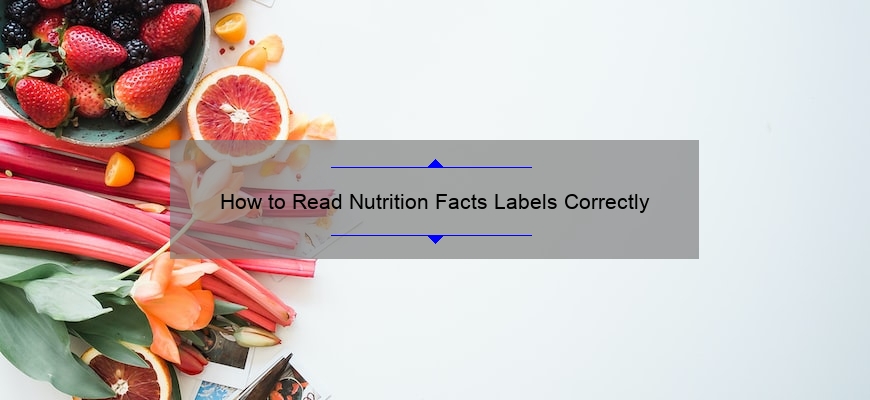When reading the nutrition facts label on a food package, you should first look at the Serving size. Too much of something can make you gain weight. Also, it would help if you looked at the list of ingredients. The high sugar content can increase your risk of weight gain. Also, you should check the Added Sugars and Sodium content.
Serving size is the first piece of information listed on the Nutrition Facts label.
The serving size is the first to look at on the Nutrition Facts label. Serving sizes have been standardized to make comparisons more accessible and are given in the customary units and metric equivalents. The serving size is crucial because it directly influences the number of calories, fat, and other nutrients you’ll consume.
The serving size is usually stated in ounces or fluid ounces. However, the amount may also be expressed in common household measurements. If the ounce amount is equivalent to metric size, it is said in 0.1 oz increments. The manufacturer may also use abbreviations for the units, such as tbsp for tablespoon or tsp for teaspoon.
The serving size is not recommended for everyone, but it provides a general guideline. For example, a single serving of plain dairy milk may contain 12 grams of total and zero Added Sugars. In contrast, a single serving of strawberry yogurt may have 20 grams of Total Sugars, including 10 grams of Added Sugars. The remaining 10 grams come from lactose and are naturally occurring.
The Nutrition Facts label should contain the serving size. It should be the first piece of information on the title and include the information that makes up a serving. The ingredient list must be listed on the label if a food contains multiple ingredients. The ingredient list should appear in descending order by weight. The ingredient information benefits people with food sensitivities, allergies, religious restrictions, and vegetarian eating styles.
Serving size is an essential piece of information for health. It is also important to note that serving size must be expressed in standard household measures. Moreover, the serving size should be the same as the label’s typeface to make the information more legible. Listed sugars on the Nutrition Facts label are naturally occurring sugars, like brown sugar and maple sugar.
Added Sugars
Reading added sugars on nutrition facts labels is essential to a healthier diet. While added sugars are not necessarily different from naturally occurring sugars, they are often higher in calories and contain fewer beneficial nutrients. For example, a carton of strawberry yogurt has 32 grams of added sugar derived from milk, strawberries, and high fructose corn syrup. Fortunately, the new Nutrition Facts label identifies the sources of added sugars.
The new labels show the sugar content as a gram per serving and as a percentage of the Daily Value. The brand also lists calories and serving sizes. For example, a 20-ounce bottle of Coke may contain 65 grams of added sugar, which is 130 percent of the recommended daily intake for adults. This change is a reflection of increased concern about the effects of sugar on the body.
The Nutrition Facts label will give the calorie content and the amount of added sugars per serving. This information is presented in descending order and includes natural and added sugars. Adding sugars can be added to products such as sweeteners or artificial sweeteners, so it is essential to read the label carefully.
Added sugars information on the NF label is intended to help consumers choose healthier foods. However, consumers may be hesitant to use this information. One study found that older consumers were more likely to disregard the added sugars information in fruit juice and ice cream. Researchers believe that poor health literacy may be a contributing factor.
Despite the new rules, most Americans are unaware that added sugars are a significant source of calories. This fact should be a warning sign to consumers and food companies. SNAP recipients may buy less than they usually would and make hedonic purchases at the grocery store.
Serving size can lead to weight gain.
Large portions promote overeating and increase energy intake. The solution to this problem is to reduce portion sizes. This can be accomplished in several ways. One obvious way is to offer smaller portions of meals, snacks, and drinks. While this method may not be effective for all consumers, it may benefit some groups.
You can also use measuring cups to estimate portion sizes. In addition, you should serve food in reasonable portions and not go back for seconds. You can also store leftovers separately or freeze them. Always request smaller pieces or order a to-go box when you eat out. It is also good to ask that servers put two-thirds of your meal in a bag for you to take home.
There is a cognitive disconnect between serving sizes on food packaging and the actual portions consumed by people. While most pieces are much larger than the recommended serving size, people don’t have a consistent way to estimate their parts. As a result, the recommended serving size is usually much larger than the actual amount.
Food package regulations
The Nutrition Facts Label (NFC) can be confusing when determining a food’s nutritional value. There is a wide variety of claims on food packaging, and consumers can get confused. In 1992, the Federal Drug Administration (FDA) created a new nutritional label called the Nutrition Facts Panel to make it easier for consumers to understand the information on their food. It was designed by a former senior advisor to the FDA commissioner, Jerold Mande. The Nutrition Labeling and Education Act (NLEA) was passed by Congress and required food manufacturers to place this new label on almost every food package.
The NFC is a panel that lists the calories, nutrients, and health benefits of a food or beverage. The board has many changes from the original version. The newer version draws attention to the total number of calories while avoiding the added sugars, which were difficult to discern. Also, the new panel includes vitamin D and potassium.
After reading the Nutrition Facts panel, consumers should also read the ingredients list. According to a survey by the International Food Information Council Foundation, nearly half of all consumers consult the ingredients list when purchasing food. This information is useful when comparing portions and the amount of each ingredient. For example, a serving size of one cup of a food item will give you twice the amount of calories, fat, and other nutrients.
A label on packaged foods should show the amount of added sugar in the serving. Adding sugars to foods can make it harder for people to meet their daily nutritional needs and stay within their calorie limits.



